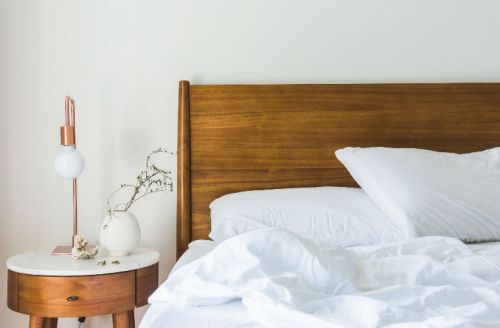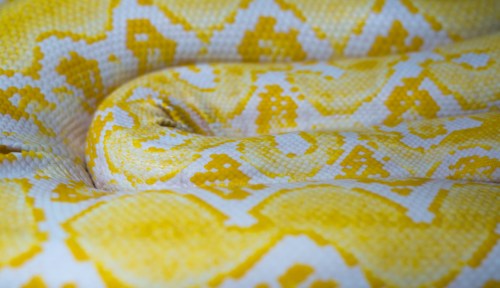How Often Should You Change Your Sheets—Really?
Laundry experts weigh in on how often you really need to be washing your sheets, to keep pathogens and bacteria at bay.

We’ve all been there: You promise yourself that you’re going to change the sheets that have been on your bed for who-even-knows-how-long. But by the time your workday ends (and you’ve squeezed in a workout), collapsing into your bed seems much more appealing than stripping it. So, you tuck yourself into the dirty sheets and swear you’ll do it tomorrow. The next morning, the cycle repeats itself.
We spend a third of our lives sleeping, and hopefully, we’re spending that time sleeping on a bed. While we love our cozy, blanket-filled beds, a lot of germs grow on them over time. From dead skin cells to sweat, our sheets start to get unsightly. So the big questions arise, when should I make time to wash my sheets? How often? Is there a wrong way to do it? Here are all the answers you’re craving.
The first thing to do with any specific fabric is to check the label. Typical labels tell you what your sheets are made from and provide washing instructions. From there, according to the Mayo Clinic, you should wash them with hot water at 130 degrees to kill mites and allergens (as long as it’s okay to wash them with hot water).
Ultimately, most experts recommend washing your bedding at least once a week, whether it be sheets or duvets. “Sheets and linens should be changed on a bi-weekly rotation—and pillowcases weekly—especially if you use a large amount of hair and skin products, according to Gwen Whiting, co-founder of The Laundress.
How often you wash your sheets depends on your lifestyle
If you’re letting Fido sleep with you or skipping post-workout showers (no judgment), for example, you should toss your bedding in the washer-dryer more often, but if you’re sleeping on silk sheets, it’s okay to let things go a little longer, microbiologist Laura Bowater, PhD says.
Don’t go too long, though, because “just one more night” in dirty sheets actually can make a difference. According to Dr. Bowater, dozens of different types of bacteria and viruses can survive on your bedsheets, including E. coli, ringworm, salmonella, herpes, norovirus, athlete’s foot, and the flu.
“You may not be able to tell from looking at bed linen if it is contaminated with microorganisms that are pathogenic,” she explains. “They can be really hard to see with the naked eye.” She, too, recommends an every-other-week wash to get rid of bacteria but notes that if you’ve been sick or share a bed with someone else, you may want to hit the laundry room more frequently.
How to tell if it’s seriously time to throw your sheets in the wash
Aside from feeling grossed out every time you have to get into them, there are a few telltale signs that your sheets are ready for a spin cycle. “Stains, discoloration, and dinginess are all sure signs of dirty sheets,” explains Lindsey Boyd, The Laundress’ other co-founder. “Additionally, any odors mean your linens are due for a wash.”
But even if you don’t see or smell any problems, it’s still important to keep things clean. Between the drooling and sweating that happens when you sleep—and whatever other activities are going on in bed that could make things feel a little dirty—regular washing is important to help maintain the appearance and integrity of a fabric.
Eight tips to keep your sheets, pillows, blankets (and mattress) clean
The following tips can help you keep your sheets, pillowcases, blankets, and even your mattress relatively germ-free:
- 1.When doing your laundry, the CDC recommends keeping your clean sheets separate from your dirty hamper. More specifically, they suggest “placing clean linen in a hamper lined with a previously unused liner, which is then closed or covered.” This keeps the germs you’re hoping to wash away off of your clean linens.
- 2.If you can, invest in allergen-proof covers and pillowcases. You can tell if something is allergen-free by checking the label: it should be made of tightly woven fabrics. For your brightest-ever sheets, the ladies of The Laundress suggest using extra-hot water in the wash. “The hotter the water, the brighter the sheets,” Whiting says. “It truly works wonders at removing stains.” They suggest using a non-toxic bleach alternative, like this one from their product line, to keep things feeling extra fresh.
- 3.If your sheets are meant to be washed in cold water, the Mayo Clinic says to put the items in the dryer for at least 15 minutes at a temperature above 130 degrees. Then wash and dry the bedding to remove allergens.
- 4.If possible, keep the humidity in your home around 50 percent. Mayo Clinic recommends investing in a dehumidifier to help measure and sustain different levels. This can help with keeping dust mites away (and off of your bedding).
- 5.According to the CDC, it’s wise to wipe down bed rails to lower exposure to pathogens.
- 6.Consider vacuuming your mattress at least once a month to keep dust, skin cells, and other allergens away.
- 7.If you already don’t do so, make your bed. Dermatologist Alok Vij, MD, told Cleveland Clinic that making your bed “will reduce the moisture that dust mites and bacteria need to proliferate.”
- 8.Lastly, if you want the cleanest mattress on the block, Home Depot suggests an easily accessible concoction to remove any stains. The retailer recommends mixing “dish soap, baking soda, and hydrogen peroxide to create a mattress stain remover.” You can use a spray bottle to target the stain and blot it with a towel or rag.
It might seem daunting but if it’s been a few months since you cleaned your bedding, it’s time to put it through the wash. And really, what’s better than snuggling into nice, clean sheets at the end of a long day? Your REM cycle will be thankful.
Oh hi! You look like someone who loves free workouts, discounts for cutting-edge wellness brands, and exclusive Well+Good content. Sign up for Well+, our online community of wellness insiders, and unlock your rewards instantly.
Sign Up for Our Daily Newsletter
Get all the latest in wellness, trends, food, fitness, beauty, and more delivered right to your inbox.
Got it, you've been added to our email list.










